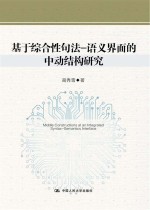图书介绍
基于综合性句法-语义界面的中动结构研究【2025|PDF|Epub|mobi|kindle电子书版本百度云盘下载】

- 高秀雪著 著
- 出版社: 北京:中国人民大学出版社
- ISBN:9787300175874
- 出版时间:2013
- 标注页数:248页
- 文件大小:52MB
- 文件页数:274页
- 主题词:英语-动词-语法-研究-英文
PDF下载
下载说明
基于综合性句法-语义界面的中动结构研究PDF格式电子书版下载
下载的文件为RAR压缩包。需要使用解压软件进行解压得到PDF格式图书。建议使用BT下载工具Free Download Manager进行下载,简称FDM(免费,没有广告,支持多平台)。本站资源全部打包为BT种子。所以需要使用专业的BT下载软件进行下载。如BitComet qBittorrent uTorrent等BT下载工具。迅雷目前由于本站不是热门资源。不推荐使用!后期资源热门了。安装了迅雷也可以迅雷进行下载!
(文件页数 要大于 标注页数,上中下等多册电子书除外)
注意:本站所有压缩包均有解压码: 点击下载压缩包解压工具
图书目录
Chapter 1 Introduction1
1.1The ResearchTopic1
1.1.1 Middle Voice and Middle Construction1
1.1.2 Middle Constructions: An Overview4
1.2 Significance of the Study7
1.2.1 Peculiarities of Middle Constructions7
1.2.2 Divergences in the Study of Middle Constructions8
1.2.3 The Linking Problem in Middle Constructions9
1.2.4 Typological Motivations9
1.3 Goals of the Study10
1.4 Organization of the Book10
Chapter 2 Delimitation of Middle Constructions13
2.1 Defining Middle Constructions Across Languages13
2.1.1 Syntactic Properties of Middle Constructions13
2.1.1.1 Active Morphology with Non-agentive Subject14
2.1.1.2 Tense and Aspect16
2.1.1.3 Adverbial Modification16
2.1.2 Semantic Properties of Middle Constructions17
2.1.2.1 Genericity17
2.1.2.2 Noneventiveness18
2.1.2.3 Modality21
2.1.2.4 Implicit Argument22
2.1.3 Middle Constructions and Related Constructions25
2.1.3.1 Middles vs.Reflexives25
2.1.3.2 Middles vs.Passives26
2.1.3.3 Middles vs.Ergatives27
2.1.3.4 Middles vs.Tough-Constructions29
2.2 Defining Chinese Middle Constructions31
2.2.1 The Scope of Chinese Middle Constructions31
2.2.1.1 The Middle Status of NP+V-qilai Constructions31
2.2.1.2 Non-middle Status of NP+V-qilai Constructions34
2.2.1.3 Notional Passives as Middle Constructions35
2.2.1.4 Patient-subject Constructions as Middle Constructions37
2.2.2 Chinese Middle Constructions and Related Constructions39
2.2.2.1 Middle Constructions vs.Passive Constructions39
2.2.2.2 Middle Constructions vs.Topic Constructions43
2.2.2.3 Middle Constructions vs.Ergative Constructions50
2.2.2.4 Middle Constructions vs.Nanyi-Constructions51
2.3 Reclassification of Middle Constructions of English and Chinese54
2.3.1 Evaluative Middle Constructions55
2.3.2 Descriptive Middle Constructions56
2.4 Summary59
Chapter 3 Previous Studies of Middle Constructions61
3.1 The Generative Approach to Middle Constructions61
3.1.1 Syntactic Accounts62
3.1.1.1 Keyser&Roeper62
3.1.1.2 Hoekstra&Roberts64
3.1.1.3 Stroik64
3.1.1.4 Problems in Syntactic Accounts66
3.1.2 Lexical Accounts69
3.1.2.1 Fagan70
3.1.2.2 Ackema&Schoorlemmer71
3.1.2.3 Chung’s Causative Approach73
3.1.2.4 Problems in Lexical Accounts74
3.1.3 A Mixed Approach76
3.1.3.1 Lekakou76
3.1.3.2 Marelj77
3.1.3.3 Problems in the Mixed Approach78
3.1.4 InterfaceAccounts78
3.1.4.1 Interface Accounts in the Minimalist Program79
3.1.4.2 Hale&Keyser80
3.1.4.3 Problems in Interface Accounts82
3.2 The Cognitive Approach to Middle Constructions82
3.2.1 Langacker83
3.2.2 The Prototype Approach85
3.2.3 Problems in Cognitive Accounts88
3.3 The Functional Approach to Middle Constructions89
3.3.1 Halliday and Davidse89
3.3.2 The Functional-Cognitive Approach89
3.3.3 Problems in Functional Accounts92
3.4 The Study of Chinese Middle Constructions93
3.4.1 The Generative Study of Chinese Middle Constructions93
3.4.2 The Cognitive Study of Chinese Middle Constructions95
3.4.3 Problems in the Study of Chinese Middle Constructions95
3.5 Summary96
Chapter 4 Theoretical Framework: An Integrated Syntax-Semantics Interface99
4.1 Where Is the Syntax-Semantics Interface?99
4.1.1 Thematic Roles100
4.1.2 Event Structure in Lexical Semantics104
4.1.2.1 Vendler’s Event Classification104
4.1.2.2 Other Major Theories of Event Structure105
4.1.2.3 Comments on Event Structure in Lexical Semantics110
4.1.3 Event Structure in the Syntactic Approach112
4.2TheTripartite Parallel Architecture114
4.2.1 Simpler Syntax114
4.2.2 Conceptual Semantics117
4.3 An Integrated Syntax-Semantics Interface118
4.3.1 The Interface of Event Structure119
4.3.2 The Interface of Qualia Structure122
4.3.3 The Interface of Information Structure125
4.3.4 A Model of Integrated Syntax-Semantics Interface127
4.4 Summary127
Chapter 5 English Middle Constructions129
5.1 Classification of English Evaluative Middle Constructions129
5.1.1 Prototypical Middles vs.Non-prototypical Middles129
5.1.2 Semantic Classification of Middles130
5.1.3 Obligatory-adverbial Middles vs.Optional-adverbial Middles131
5.1.4 Simple Middles vs.Complex Middles in Tense and Aspect132
5.2 English Evaluative Middles at the Integrated Interface132
5.2.1 Event Structure Accounts of English Evaluative Middles132
5.2.1.1 The Event Schema of English Evaluative Middles133
5.2.1.2 Event Accounts for Implicit Argument135
5.2.1.3 Event Accounts for Non-agentive Subject136
5.2.1.4 Event Accounts for Selection Restrictions of Verbs138
5.2.1.5 Event Accounts for Selection Restrictions of Adverbials142
5.2.2 Qualia Structure Accounts of English Evaluative Middles144
5.2.2.1 Long-standing Puzzles in Middle Formation145
5.2.2.2 Accounts for Puzzles in Middle Formation146
5.2.3 Information Structure Accounts of English Evaluative Middles149
5.2.3.1 Newsworthiness and Adjuncts150
5.2.3.2 Topic and Focus and Argument Realization152
5.3 Classification of English Descriptive Middle Constructions153
5.3.1 Passival Middles153
5.3.2 Habitual Middles154
5.4 English Descriptive Middles at the Integrated Interface155
5.4.1 Event Structure Accounts of English Descriptive Middles155
5.4.2 Qualia Structure Accounts of English Descriptive Middles156
5.4.3 Information Structure Accounts of English Descriptive Middles157
5.5 Relations Between Evaluative and Descriptive Middles157
5.6 Summary158
Chapter 6 Chinese Middle Constructions161
6.1 The Structure of Chinese Evaluative Middles161
6.1.1 The Structural Parsing of V-qilai Middles161
6.1.2 The Grammatical Status of V-qilai and AP164
6.1.2.1 Adjunct Analysis164
6.1.2.2 Middle Hypothesis166
6.1.2.3 Secondary Predicate Hypothesis168
6.1.2.4 NP+Predicate+Complement170
6.1.3 The Grammatical Function of Qilai in V-qilai Middles172
6.2 Chinese Evaluative Middles at the Integrated Interface176
6.2.1 Event Structure Accounts of V-qilai Middles176
6.2.1.1 The Event Schema of V-qilai Middles176
6.2.1.2 Event Accounts for Implicit Argument177
6.2.1.3 Event Accounts for Non-agentive Subject178
6.2.1.4 Event Accounts for Selection Restrictions of Verbs179
6.2.1.5 Event Accounts for Selection Restrictions of AP183
6.2.2 Qualia Structure Accounts of V-qilai Middles185
6.2.3 Information Structure Accounts of V-qilai Middles187
6.2.4 A Comparison Between V-qilai Middles and Nanyi-middles188
6.3 Syntactic and Semantic Features of Chinese Descriptive Middles190
6.3.1 Syntactic Features of Descriptive Middles190
6.3.2 Semantic Features of Descriptive Middles194
6.4 Chinese Descriptive Middles and the Integrated Interface197
6.4.1 Event Structure Accounts of Descriptive Middles197
6.4.1.1 The Event Schema of Descriptive Middles197
6.4.1.2 Event Accounts for Selection Restrictions of Predicate199
6.4.2 Qualia Structure Accounts of Descriptive Middles204
6.4.3 Infonnation Structure Accounts of Descriptive Middles208
6.5 Relations Between Evaluative and Descriptive Middles209
6.6 Summary210
Chapter 7 Typological Accounts of Middle Constructions211
7.1 Differences Between English and Chinese Middle Constructions211
7.1.1 Productivity211
7.1.2 Sensitivity to the Constraints of Middle Formation214
7.1.3 Context-dependency216
7.2Typological Accounts for the Differences217
7.2.1 Subject-prominence vs.Topic-prominence217
7.2.1.1 Subject and Topic in English and Chinese218
7.2.1.2 Topic in English Middle Constructions219
7.2.1.3 Topic in Chinese Middle Constructions220
7.2.2 Flexibility of Argument Realization221
7.2.2.1 Unselectiveness of Arguments221
7.2.2.2 Specific Lexicalization Pattern of Verbs223
7.2.3 Tense-prominence vs.Aspect-prominence224
7.3 Summary226
Chapter 8 Conclusions229
8.1 Major Findings of This Study229
8.2 Implications of This Study231
8.3 Suggestions for Future Study232
Bibliography233
热门推荐
- 1334173.html
- 751307.html
- 3464293.html
- 581601.html
- 3566532.html
- 361784.html
- 1366978.html
- 708055.html
- 2818945.html
- 1230106.html
- http://www.ickdjs.cc/book_3778043.html
- http://www.ickdjs.cc/book_1920573.html
- http://www.ickdjs.cc/book_2349060.html
- http://www.ickdjs.cc/book_1493363.html
- http://www.ickdjs.cc/book_929980.html
- http://www.ickdjs.cc/book_939872.html
- http://www.ickdjs.cc/book_1475609.html
- http://www.ickdjs.cc/book_2706556.html
- http://www.ickdjs.cc/book_566915.html
- http://www.ickdjs.cc/book_2788255.html